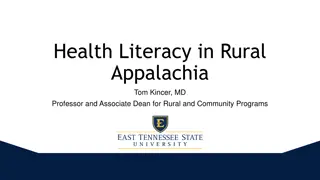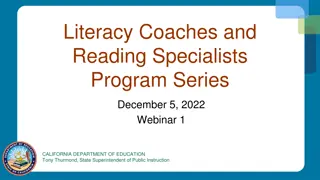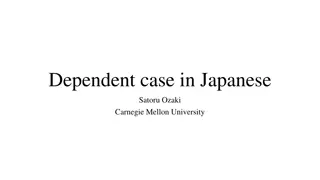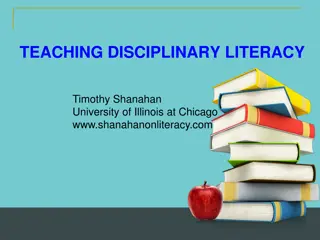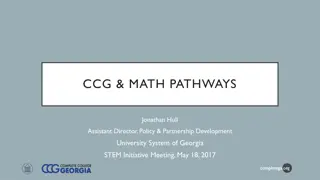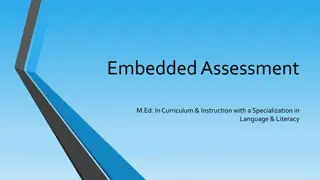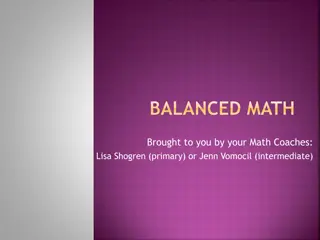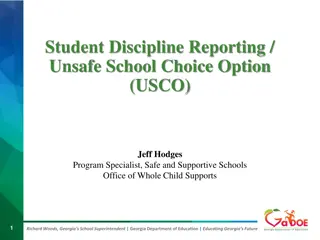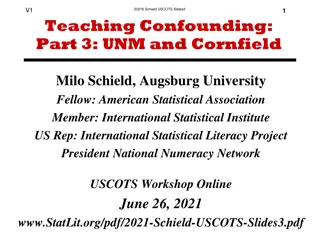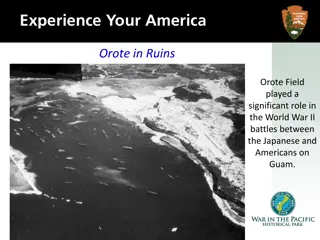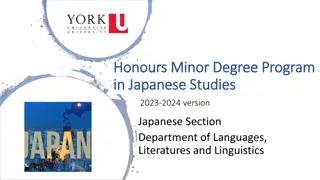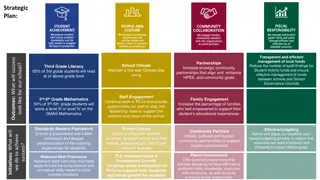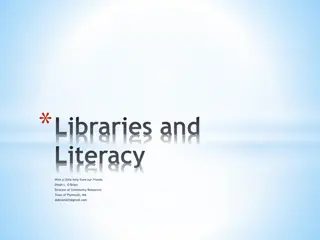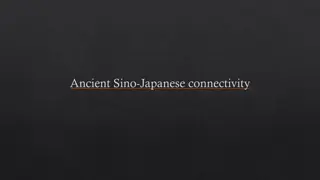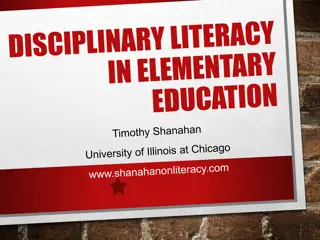Japanese Lesson Study: Enhancing Discipline Literacy in Science and Math
Study conducted at University of North Carolina focused on Japanese Lesson Study (LS) as a form of action research to improve discipline literacy in science and math. The LS method, a structured form of action research, involves specific team activities for research, decision making, implementation, and reflection. Theoretical framework highlights practitioner inquiry based on teacher-generated problems and attributes of effective professional development. The lesson study cycle involves collaborative planning, observing, and discussing classroom lessons. Traditional vs modern lesson study approaches are compared in terms of communication, relationships, and research-practice integration. Project participants included teachers from rural North Carolina schools with diverse ethnic and gender representation.
Uploaded on Sep 19, 2024 | 3 Views
Download Presentation

Please find below an Image/Link to download the presentation.
The content on the website is provided AS IS for your information and personal use only. It may not be sold, licensed, or shared on other websites without obtaining consent from the author.If you encounter any issues during the download, it is possible that the publisher has removed the file from their server.
You are allowed to download the files provided on this website for personal or commercial use, subject to the condition that they are used lawfully. All files are the property of their respective owners.
The content on the website is provided AS IS for your information and personal use only. It may not be sold, licensed, or shared on other websites without obtaining consent from the author.
E N D
Presentation Transcript
JAPANESE LESSON STUDY AS A FORM OF ACTION RESEARCH TO IMPROVE DISCIPLINE LITERACY IN SCIENCE AND MATH Irina Falls, Department of Educational Specialties Rita Hagevik, Department of Biology University of North Carolina at Pembroke, U.S.A.
OBJECTIVES The study focused on the defining characteristics of LS that make it unique among other forms of AR. Conceptualization and classification of LS revealed that it is a very structured form of AR requiring specific team activities for research, decision making, implementation, and reflection.
THEORETICAL FRAMEWORK The LS method of practitioner inquiry is based on a teacher-generated problem around student learning. The ideal attributes of effective professional development are perfectly aligned with the LS model: intensive, ongoing, and connected to practice; focus on student learning and addressing the teaching of specific curriculum content; aligned with school and district improvement priorities and goals; built upon strong working relationships among teachers; engagement in social constructivism and reflection
TEACHERS ACTIVITIES TO IMPROVE INSTRUCTION Choose curriculum, write curriculum, align curriculum, write local standards Plan lessons individually Plan lessons collaboratively U.S. JAPAN Watch and discuss each other s classroom lessons Catherine C. Lewis 2005
PROFESSIONAL DEVELOPMENT TRADITIONAL LESSON STUDY Begins with answer Begins with question Driven by expert Driven by participants Communication is vertical trainer -> teachers Communication is horizontal - among teachers Relationships hierarchical Relationship reciprocal Research informs practice Practice is research
PROJECT PARTICIPANTS (N=11) Public Schools of Robeson County teachers 2 middle schools in rural southeast North Carolina 1 team of 6 math teachers (7th and 8th grade) 1 team of 5 science teachers (7th and 8th grade) Ethnic distribution: 36% Native American 27% Caucasian 27 % Hispanic 9% African American Gender: 37% males 63% females
PROJECT PD ACTIVITIES 150 hours of Professional Development during the school year During the one week summer institute they learned the three goals of the project: Strategies to teach Disciplinary Literacy (DL); Increase use of mobile devices and teaching apps; Learning the Japanese Lesson Study form of PD. Lesson Study cycle using practice lessons focused on what to observe and Interactive online module focused on teaching methods for DL. LS cycles facilitated by LS trainers. The teams formed across schools and around grade levels in one district that had only ELA teachers, and around subject in the school district with math and science teachers
DATA SOURCES 1. Likert style pre- and post-surveys on teachers knowledge about and preparedness to implement both the DL strategies and the LS. 2. Monthly reflections on main project activities. 3. Semi-structured exit interviews (7 teachers) about main components of the project aligned with the research questions.
DATA ANALYSIS SPSS (2014) to analyze the surveys quantitative data through a paired sample t-test comparing pre-survey scores to final ones by theme. Qualitative software program (MAXQDA) for analysis of survey open-ended questions, reflections, and interviews taken together.
PAIRED SAMPLES T TESTS AND THEIR SIGNIFICANCE Effect size (Cohen s d) Sig. (2- tailed) Std. t Deviation Mean Total knowledge pre- and post -22.789 5.094 -19.499 p< .000 -4.47369 Total preparedness pre- and post -2.17549 -9.000 4.137 -9.484 p< .000 Total Lesson Study knowledge and preparedness pre- and post -3.54181 -14.316 4.042 -15.437 p< .000 Total disciplinary literacy knowledge and preparedness pre- and post -3.03455 -16.684 5.498 -13.227 p< .000 Total technology use and knowledge pre- and post p< .000 -1.25356 -2.84211 2.26723 -5.464
RESULTS TABLE 1: SELECT SURVEY RESPONSES ABOUT THE KNOWLEDGE GAINED ABOUT DL STRATEGIES (FINAL SURVEY) Strongly disagree I know how to engage students in disciplinary literacy I know how to apply disciplinary literacy in your teaching context or classroom. I know how to create engaging lessons utilizing inquiry-based disciplinary literacy I know how to evaluate student learning within an inquiry-based disciplinary literacy Disagree Neutral Agree Mean SD Strongly agree 0% 3.85% 7.69% 23.07% 65.38% 4.08 0.67 0% 3.85% 11.53% 61.54% 23.07% 4.04 0.71 0% 7.69% 15.38% 50% 26.92% 3.96 0.85 0% 7.69% 11.53% 61.54% 19.23% 3.92 0.78
DIFFERENCES IN TEACHERS PERCEIVED KNOWLEDGE IN DISCIPLINARY LITERACY PRE- AND POST-PROGRAM Pre-test Post-test N Mean SD Mean SD t (10) P < d Effect size Disciplinary literacy knowledge and preparedness to implement 11 21.37 4 44.16 5.881 -15.437 .000 -3.03455
RESULTS TABLE 2: SELECT SURVEY RESPONSES ABOUT THE USEFULNESS OF THE LS MODEL OF PRACTITIONER INQUIRY AND PROFESSIONAL DEVELOPMENT 2 disagree Disagree Neutral Agree Mean SD Strongly Strongly agree My LS team collaborated effectively to plan a research lesson Developing the research lesson as a team allowed me to think deeply about issues in my content or teaching I know how to conduct an implementation of a LS cycle I know how to identify a research theme for a Lesson Study cycle 0% 0% 8% 38% 54% 4.461 0.64 0% 0% 15% 50% 35% 4.2 0.7 0% 0% 7.69 % 19.25% 73.08% 4.12 0.51 0% 15.38 % 61.54 % 19.23 % 3.85 % 3.92 0.83
DIFFERENCES IN TEACHERS PERCEIVED COMPETENCIES IN LESSON STUDY PRE- AND POST-PROGRAM Pre-test Post-test t (10) P< d Mean SD Mean SD N Effect size Lesson Study knowledge and preparedness to implement 11 9.68 2.82 24 3.55 -15.437 .000 -3.54181
TEACHERS PERCEPTIONS OF LS AS EDUCATIONAL AR AND PD AND THEIR THOUGHTS ABOUT ITS IMPACT ON THEIR PRACTICE The aspects of Lesson Study teachers valued the most define it as a very structured form of Action Research: Teaming and Collaboration Focus on the Student Context-based Getting the Whole Picture - while planning a single lesson, teachers considered the entire teaching unit and the sequencing of lessons with their respective goals and objectives Intentionality in Teaching Reflection
CHANGES IN THE TEACHERS BELIEFS AND PERSPECTIVE ON THEIR PRACTICE Increased confidence in their and their colleagues ability to change their teaching practice through collaboration. Belief that LS is a sustainable model for professional development given the full support of the administration.
TEACHERS REFLECTIONS ABOUT DISCIPLINARY LITERACY The lesson study was a great tool to see which students were getting the information and which were not. It also allowed me to see students' interactions at critical times in the lesson and how they responded to those times. The card sort told me a lot about how students organize their thinking, students struggle in working with groups. Students work really well when they graphic organizers, clearly stating the learning target, and being more aware of student engagement
TEACHER INTERVIEW RESPONSES ABOUT LESSON STUDY Collaboration between colleagues led to a better lesson plan. Positive was being able to bounce ideas off of the other teachers. Really felt collaboration amongst the math teachers. Really felt the true meaning of a lesson study preparation. It felt much more efficient and effective than if I had planned it on my own. Discussing and researching our individual lesson was really a group effort.
TEACHER INTERVIEW RESPONSES ABOUT LESSON STUDY There was a lot of collegiality, reflection, and positive relationships. Lesson study will positively affect student learning because of all the thoughtful planning, collaboration, reflection and intensive focus on student learning. I learned to examine and reflect on what happened in the classroom, especially student behaviors. I was not used to do this.
DISCUSSION Teachers instructional beliefs, perceived benefits, and reported effectiveness of their practice changed remarkably LS fits into the AR category that Somekh and Zeichner (2009) described as a locally-sponsored systemic reform sustained over time The collaboration aspect of the LS was identified as the most valuable part of the project. LS requires the team to plan and collaborate Although LS is cyclic like most forms of AR, the continuation of LS cycles is necessary LS provides an opportunity to develop a shared vision of high quality instruction among teachers, school and district leaders, and policymakers
FUTURE RESEARCH Study the implementation of LS for several years to examine the effects and sustainability of such a continuous model of context-based professional development. Conduct comparative studies of both LS and other forms of AR to distinguish differences and similarities.
REFERENCES Akiba, M., Murata, A. & Wilkinson, B. (2016). Race to the Top and Lesson Study Implementation in Florida: District Policy and Leadership for Teacher Professional Development. Working Paper. Tallahassee, FL: Florida State University. Bryk, A. (2015). Accelerating how we learn to improve (2014 AERA Distinguished Lecture). Educational Researcher, 44(9), 467-477. Lewis, C. (2005). How do teachers learn during lesson study? In P. Wang-Iverson & M Yoshida (Eds.) Building our understanding of lesson study. Philadelphia, PA: Research for Better School Inc. Lewis, C. (2015). What is improvement science? Do we need it in education? Educational Researcher, 44(1), 54-61. Somekh, B., and K. Zeichner. (2009). Action Research for Educational Reform: Remodeling Action Research Theories and Practices in Local Contexts. Educational Action Research 17 (1): 5 21. Zeichner, K. M., and S. E. Noffke. 2001. Practitioner Research. In Handbook of Research on Teaching. 4th ed. edited by V. Richardson, 298 330. Washington, DC: American Educational Research Association.
FUNDING FOR THIS STUDY WAS PROVIDED BY: LEARNING ANDLITERACY THROUGH LESSON STUDY IN MIDDLE SCHOOL (IN SERVICE TEACHERS OF STUDENTS OF AGES 11-14) Funded by a grant awarded by the US Department of Education through state agencies of higher education (SAHEs) to eligible educational partnerships, under the No Child Left Behind Act {Title II- A, Subpart 3}, US Dept. of Ed Award # S367B120048. A collaborative effort of faculty members in the University of North Carolina Pembroke (UNCP) School of Education and College of Arts and Sciences, and of key personnel in the two regional school districts.
irina.falls@uncp.edu rita.hagevik@uncp.edu




